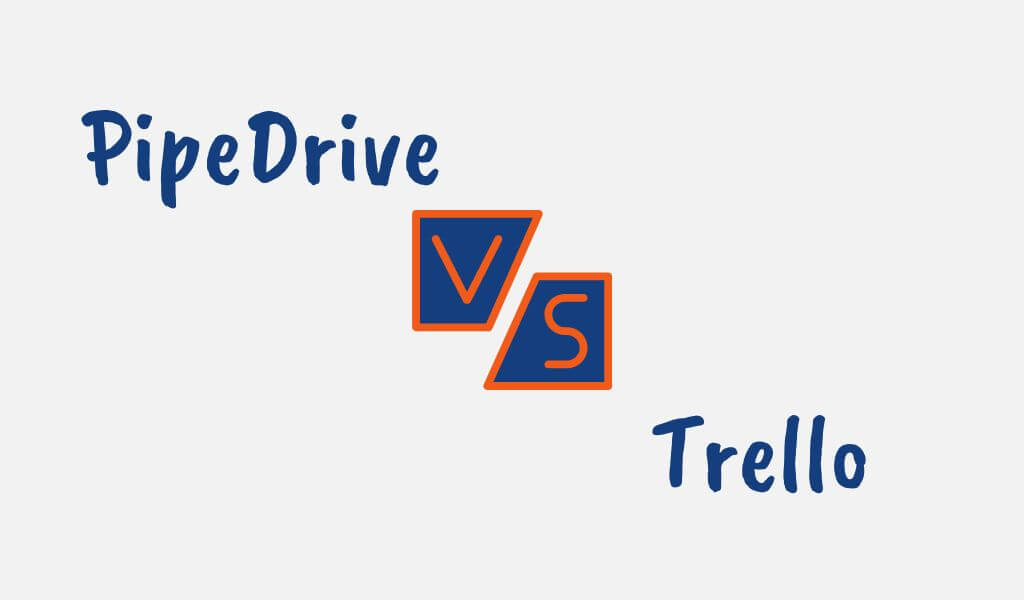When it comes to managing projects, customer relationships, and sales pipelines, businesses are constantly looking for the best tools to streamline their processes and meet constantly evolving KPIs.
To stay productive as a business, you need the best tools to help meet your goals. Pipedrive and Trello are two popular tools that can help cater to different aspects of customer relationships and project management.
If you are looking at which of these apps can help in managing your business, this Pipedrive vs Trello comparison provides an overview of their individual features, differences, use cases, and integration possibilities to help you decide which is best suited for your business needs.
Pipedrive Overview: A Powerful CRM Solution
Pipedrive is a cloud-based Customer Relationship Management (CRM) tool that is designed to help businesses manage their sales process, especially small and medium businesses.
You can use Pipedrive to create a sales pipeline and track your progress, and it happens to be a tool that’s friendly and relatively easy to set up.

Key Features and Functionalities of Pipedrive as a CRM Software
Some of the key features of Pipedrive include:
Contact Management
Pipedrive allows you to manage all your contacts in one place. It’s easy to find and organize contacts, and it allows you to store all the information about a contact in one place.
Lead Management
Pipedrive helps you track leads from different sources. The tool makes it easy to keep track of leads, follow up with them, and convert them into customers.
Sales Pipeline Management
Pipedrive gives you a clear view of your sales pipeline. The tool visualizes your sales process, and it gives you a clear view of where you stand in the process.
Email Integration
It lets you automate email correspondence with leads and customers. Pipedrive allows you to set up automated email sequences, which saves time and improves the efficiency of your sales process.
Reporting and Analytics
It provides detailed reports and analytics to help you understand your sales process. Pipedrive’s analytics provide insights into your sales pipeline, deal volume, and more.

Pros and Cons of Pipedrive
Pipedrive offers a wide range of features that are tailored to the specific needs of sales teams, making it an attractive option for many businesses.
However, as with any tool, it’s important to weigh the pros and cons before making a decision to utilize it for your business processes.
Pros of Pipedrive
1. Sales Management
Pipedrive provides a pipeline-based approach to sales management, which allows sales teams to easily track progress and forecast future sales.
This visual approach allows sales teams to see their pipeline at a glance, which can help them prioritize their work and identify areas for improvement.
Additionally, Pipedrive’s drag-and-drop functionality makes it easy to move deals through the pipeline, which can help sales teams stay on top of their progress.
2. Automation
Pipedrive offers a variety of automated features such as automated email and task reminders, which make it easier for sales teams to stay on top of deadlines.
This feature can help sales teams stay organized and ensure that they don’t miss important follow-up tasks by doing them manually.
Additionally, the triggers for this automation can be set based on specific actions, such as a deal moving to a certain stage in the pipeline.
3. Integrations
Pipedrive offers a wide range of integrations with popular tools such as Mailchimp, Zapier, LinkedIn Sales Navigator, and many more.
This allows sales teams to easily connect Pipedrive with other tools they are already using to streamline their workflow and automate tasks.
4. Views and Dashboards
Pipedrive offers customizable views and dashboards that are more advanced and tailored for sales teams.
Sales teams can track key metrics such as conversion rates and forecast future sales, and view detailed analytics on their pipeline.
This allows sales teams to have a clear picture of their sales process and identify areas for improvement.
Additionally, Pipedrive’s built-in calendar allows sales teams to schedule follow-up tasks and set reminders, which can help them stay on top of their work.
5. Customer Support
Pipedrive offers more resources such as a help center and training resources, as well as a dedicated customer support team that can be reached via email, phone, and chat.
This ensures that sales teams can get the help they need when they need it, which can help them stay productive and on track.
Cons of Pipedrive
1. Learning Curve
Pipedrive’s advanced features can take some time to learn and navigate, which can be a bit of a learning curve for new users.
This can be especially challenging for sales teams that are new to using CRM tools.
2. Pricing
Pipedrive’s pricing can be a bit more expensive than other CRM tools on the market. This can be a concern for businesses that are on a tight budget.
3. Limited Collaboration
While Pipedrive allows for collaboration, it is more focused on sales management, and not as much on teamwork.
This can be an issue for sales teams that rely heavily on collaboration and teamwork to get their work done.
4. Limited Customization
Pipedrive’s pipeline-based approach is great for sales management but can be limiting for teams that need more flexibility in their process.
It’s not as customizable as some other CRM tools and may not fit the specific needs of certain teams.
5. Limited Mobile App
The mobile app of Pipedrive is not as complete as the web version, and some features may not be available. This can be an issue for sales teams that rely heavily on mobile access to their CRM tool.
Trello Overview: A Versatile Project Management Tool
Trello is a web-based project management and collaboration tool that utilizes a board and card-based interface to help teams organize tasks and workflows.
It is suitable for businesses of all sizes and can be used for a wide range of projects and use cases as it offers a range of tools to help keep track of progress, set deadlines, and create checklists.
Trello’s interface consists of boards, lists, and cards. Boards represent projects or categories, lists represent stages or steps, and cards represent individual tasks or items.
Users can easily move cards between lists to track progress, set due dates, and assign tasks to team members.

Key Features and Functionalities of Trello
Some of the key features of Trello include:
1. Task Management
Trello allows you to create, assign, and track tasks. It makes it easy to see what needs to be done, who is responsible for it, and when it needs to be done.
2. Collaboration
It lets team members work together in real time. Trello’s collaboration features make it easy to work on projects together and keep everyone on the same page.
3. File Sharing
Trello facilitates easy sharing of files and documents. It allows you to upload files, images, and documents to tasks, making it easy for team members to access the files they need.
4. Progress Tracking
It gives you a clear view of the progress of your projects. Trello’s visual interface makes it easy to see which tasks are complete, which tasks are in progress, and which tasks are yet to be started.
5. Deadline Setting
It helps you keep your projects on schedule. Trello’s deadline feature allows you to set deadlines for tasks and projects, making it easy to ensure that everything is completed on time.

Pros and Cons of Trello
Trello while known for its user-friendly interface and real-time collaboration features, making it a popular choice among teams and individuals alike also has its pros and cons.
Pros of Trello
1. User-Friendly Interface
Trello’s interface is intuitive and easy to use, making it accessible for users of all skill levels. The drag-and-drop functionality allows users to easily move tasks and projects around, and the color-coding system makes it easy to identify and prioritize tasks.
Also, Trello’s interface is customizable, allowing users to personalize their boards to fit their specific workflow and needs.
2. Collaboration
Trello allows for real-time collaboration and teamwork, making it easy to assign tasks and leave comments on cards.
This feature is especially useful for teams that work remotely, as it allows for clear communication and keeps everyone on the same page.
Trello’s @mention system also makes it easy to notify team members of tasks and updates.
3. Customization
Trello allows you to customize boards, lists, and cards to fit your specific workflow and needs. This allows users to tailor the tool to their specific work process, which can help them stay organized and productive.
4. Integrations
Trello offers a variety of integrations with popular tools such as Google Drive, Slack, and Evernote which enables users to easily connect Trello with the other tools they are already using, streamlining their workflow and automating tasks.
5. Mobile App
Trello offers a mobile app that is user-friendly and allows you to access your boards on the go. For users who are constantly on the move, they can easily access their tasks and projects from anywhere.
Cons of Trello
1. Limited Automation
Trello does not offer as many automation options as other project management tools and this can be an issue for teams that rely heavily on automation to stay organized and productive.
2. Limited Reporting Features
Also, Trello does not offer advanced reporting and analytics features. For teams that need detailed insights into their progress and performance, this could be a deal-breaker.
3. Limited Security
Another concern with Trello is its limited security features in comparison with other project management tools, making it less suitable for businesses handling sensitive data.
4. Limited Features for Sales Management
Trello is not as tailored for CRM-specific features like sales pipelines and lead management.
The Key Differences between Pipedrive and Trello
To further understand how each of these tools works and their differences, a comparison of their key features is given.
This way, you can decide which tool to use based on the particular features that are more important to you.
1. Primary Function
Pipedrive is primarily a CRM (customer relationship management) tool that is designed to help sales teams manage their pipeline and track progress.
With Pipedrive, sales teams can easily manage their sales pipeline, customize deal stages, and forecast future sales.
For example, a sales team using Pipedrive can set up different stages in their pipeline such as lead, opportunity, and closed deal, and move deals through the pipeline with drag-and-drop functionality.
On the other hand, Trello is a general-purpose project management tool that offers a range of features for task management, collaboration, and teamwork.
2. Automation
Pipedrive offers a variety of automated features that make it easy for sales teams to stay on top of deadlines.
For example, using Pipedrive, a sales team can set up automated email reminders to follow up with leads or automated task reminders to schedule calls with clients.
The triggers for this automation can be set based on specific actions, such as a deal moving to a certain stage in the pipeline.
On the other hand, Trello also offers automation capabilities, but it is not as robust as Pipedrive.
An example of automation in Trello would be setting up a “rule” that triggers an action, such as automatically moving a card to a specific list or assigning a specific member when certain conditions are met, such as when a card is labeled with a certain tag.
Pipedrive’s automation is more geared towards sales management while Trello’s automation is more focused on task management with the ability to set up automations based on specific triggers and actions.
Integrations
Pipedrive offers a wide range of integrations with popular tools such as Mailchimp, Zapier, LinkedIn Sales Navigator, and many more.
These integrations allow sales teams to easily connect Pipedrive with other tools they are already using to streamline their workflow and automate tasks.
Trello also offers integrations, but not as many as Pipedrive. Some examples of integrations that Trello offers include Google Drive, Slack, and Asana.
Both Pipedrive and Trello offer integrations to make the workflow more seamless, but Pipedrive has more options for integration.
Views and Dashboards
Both Pipedrive and Trello offer customizable views and dashboards, but Pipedrive’s views and dashboards are more advanced and tailored for sales teams.
For example, a sales team using Pipedrive can track key metrics such as conversion rates and forecast future sales, and view detailed analytics on their pipeline.
This allows sales teams to have a clear picture of their sales process and identify areas for improvement.
On the other hand, Trello’s views and dashboards are more focused on task management. Trello allows users to create boards and cards to visualize their tasks and progress. This makes it easy to create and edit cards and boards and track progress.
Customer Support
Both Pipedrive and Trello offer customer support, but Pipedrive offers more resources such as a help center and training resources.
For example, a sales team using Pipedrive can access a variety of resources such as tutorials, webinars, and a knowledge base to help them get the most out of the tool.
Pipedrive also offers a dedicated customer support team that can be reached via email, phone, and chat.
On the other hand, Trello also offers customer support, but it is not as extensive as Pipedrive.
Trello offers support through email and a help center, but it doesn’t have the same level of resources and dedicated support team.
Task Management
Both Pipedrive and Trello offer a range of features for task management, albeit with different approaches.
Pipedrive uses a pipeline-based approach to sales management, which allows sales teams to easily track progress and forecast future sales.
For example, a sales team using Pipedrive can set up different stages in their pipeline such as lead, opportunity, closed deal, and move deals through the pipeline with drag-and-drop functionality.
They can also use the built-in calendar to schedule follow-up tasks, set reminders, and create custom fields to add more context to deals.
On the other hand, Trello uses a Kanban-style board to help you visualize your tasks and progress, making it easy to create and edit cards and boards.
Trello also allows you to assign tasks to team members, attach files, create checklists, and set due dates and labels.
Collaboration and Task Assignment
Both Pipedrive and Trello offer collaboration and teamwork capabilities, but Trello is more geared towards collaboration.
Trello allows team members to collaborate in real time, assign tasks to team members, and leave comments and feedback on tasks.
Team members can also be given different levels of access and permissions to ensure that the right people have access to the right information.
Trello also allows users to create groups and boards that are visible to specific team members only.
On the other hand, Pipedrive allows for collaboration, but it is more focused on sales management, and not as much on teamwork.
Pipedrive allows team members to share access to deals, track progress and forecast future sales, but it doesn’t have the same level of collaboration features as Trello.
Pricing
Pipedrive offers different pricing tiers based on the number of users and it is a monthly subscription-based service.
The pricing options for Pipedrive are:
- Essential: €14.90 per user per month, billed annually
- Advanced: €24.90 per user per month, billed annually
- Professional: €49.90 per user per month, billed annually
- Enterprise: €79.90 per user per month, billed annually
Each of these plans has a 14-day free trial period.
On the other hand, Trello offers free and paid plans. The pricing options for Trello are:
- Free: Free, intended for individuals.
- Standard: $5/month per user per month, billed annually
- Premium: $10/month per user, intended for teams that need multiple tracking methods.
- Enterprise: $17.50/month per user, intended for organizations.
Trello also offers discounts for non-profit and education organizations.
In comparison, Pipedrive’s pricing is more flexible and tailored to the specific needs of a sales team while Trello’s pricing is more focused on the size of the team and the level of features needed.

Pipedrive vs Trello: Which is Right for You?
By now, you should have a good idea of how both tools help businesses streamline operations and their distinct differences.
If you have to choose between Pipedrive and Trello, then it’s important to consider the specific needs of your business first.
While Pipedrive is a CRM tool focusing on sales, Trello is a project management tool that focuses on collaboration and task management.
Pipedrive offers more advanced sales-specific features, such as lead management, pipeline management, and email automation, while Trello offers a more flexible platform for managing tasks and projects.
Trello’s visual interface, collaboration features, and file-sharing capabilities make it well-suited for managing tasks and projects across teams.
If you’re primarily looking for a tool to manage your sales process, Pipedrive is the best choice. It’s an all-in-one sales management tool that can help you manage leads, track deals, and automate repetitive tasks.
However, if you’re looking for a more flexible project management tool, then Trello is a great option. It’s a user-friendly and easy-to-use tool that can help you manage tasks and projects across teams, and it offers a range of features to help you stay on schedule.
Conclusion
Both Pipedrive and Trello offer valuable features that cater to different aspects of sales and project management.
By comparing their strengths, weaknesses, and use cases, you can determine which platform (or combination of platforms) is best suited for your organization’s needs.
By integrating Pipedrive and Trello effectively, you can enjoy the best of both worlds and unlock the full potential of both platforms.
FAQs
Can Trello be Used for Sales Management?
Trello is primarily used for project management and task management, but it can also be used for some aspects of sales management, such as tracking deals and creating checklists.
However, it lacks some of the advanced sales-specific features that are found in Pipedrive.
Does Pipedrive have a Project Management Feature?
Pipedrive is mainly a CRM tool that is geared towards sales management. While it has some limited project management features such as creating a pipeline and tracking deals, it’s not as flexible as project management-specific tools such as Trello.
Can Pipedrive and Trello be used together?
Yes, Pipedrive and Trello can be used together. By integrating both tools, sales teams can use Pipedrive to manage their pipeline and forecast future sales, while using Trello to manage tasks and collaborate with their team.
How can Pipedrive and Trello be integrated together?
Both Pipedrive and Trello offer integrations with other tools and apps. You can use tools like Zapier or Integromat to integrate Pipedrive and Trello together. This allows for data to be seamlessly passed between the two tools, creating a more efficient workflow.
Will using Pipedrive and Trello together make my workflow more complex?
No, using Pipedrive and Trello together doesn’t necessarily make your workflow more complex. In fact, integrating these tools can enhance productivity by leveraging their respective strengths.
Pipedrive focuses on sales and CRM, while Trello excels in project management and collaboration. Integrating them can streamline your processes and create a seamless flow between sales and project activities, leading to improved efficiency and visibility.
Are there any limitations to using Pipedrive and Trello together?
The integration between Pipedrive and Trello is not a native integration, so it may require additional setup and configuration, and there could be some learning curve for team members.
Additionally, managing data across two platforms might require extra effort. However, with proper planning and training, these limitations can be mitigated, and the combined power of Pipedrive and Trello can significantly enhance your workflow and productivity.





